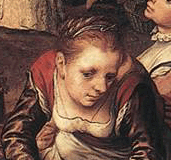 First I have to tell you the first thing I see when I look at these paintings. Tits! Now, don't get me wrong -- I am not a woman obsessed by breasts. But the prevailing method of contructing these market women dresses produces a flat and conical torso. Matter of fact, one of the proponents of this construction actually calls it "the flat and slightly elevated bosom".
First I have to tell you the first thing I see when I look at these paintings. Tits! Now, don't get me wrong -- I am not a woman obsessed by breasts. But the prevailing method of contructing these market women dresses produces a flat and conical torso. Matter of fact, one of the proponents of this construction actually calls it "the flat and slightly elevated bosom".
Friends, does this (left) look flat and slightly elevated to you? 'Cuz to my eye, that's big, round, and slightly droopy being barely contained from bursting forth by the strength of her partlet alone. As my darling Partner in Life would say: "Dem's some bosoms!"
And this isn't the only picture showing this silhouette. Matter of fact, in all of my flipping through books and websites and seeing photographs friends took in the museums, there is only one single painting where the bosom could be described as "flat and slightly elevated". Indeed, in that particular paining ("Fire" from Joachim Beuckalaer's "Four Elements" series), the woman standing in the left foreground with a chicken in one hand and a rotisserie in the other looks so conical and flat that it could be argued she's wearing boned stays.
But I fear I'm straying from the point. Here are a few more pictures of women who appear to have round and non-lifted bosoms:






If those are flat and slightly lifted, friends, I'm a monkey's uncle!
 What I believe we're seeing here is a dress of the kirtle type laced over a soft unstiffened stomacher. In some of the paintings above, you can see the stomacher wrinkling and gapping as a boned stomacher or fitted underdress will not. In some the stomacher does not come up high enough to cover the breasts; it is merely located under the lacing and stops where it does. This varies from painting to painting. In the picture above ("Water" from Joachim Beuckalaer's "Four Elements" series) in particular you can see the edges of the stomacher sticking out past the edges of the kirtle, proving it is not an underdress. Look up!
What I believe we're seeing here is a dress of the kirtle type laced over a soft unstiffened stomacher. In some of the paintings above, you can see the stomacher wrinkling and gapping as a boned stomacher or fitted underdress will not. In some the stomacher does not come up high enough to cover the breasts; it is merely located under the lacing and stops where it does. This varies from painting to painting. In the picture above ("Water" from Joachim Beuckalaer's "Four Elements" series) in particular you can see the edges of the stomacher sticking out past the edges of the kirtle, proving it is not an underdress. Look up!
Another breast-related phenomenon I've noticed in the paintings is that the front of the gown doesn't appear to cover the breasts at all. In almost every painting, the edge of the laced section is aligned with the edge of the shoulder strap, indicating that they are cut apiece and not cut separately and sewn together. The shoulder straps skirt the outside of the bosom and continue into the laced area where they draw a little closer because of the lacing. This indicates a completely different construction technique to that being purported thusfar.
In our next installment, I will show you what my experience studying extant common women's garments from the 16th century has taught me and how I think the Netherlandish Working Woman's outfit was made.
Next: The Reconstruction of the Bodice
© 2007 Kass McGann. All Rights Reserved. The Author of this work retains full copyright for this material. Permission is granted to make and distribute verbatim copies of this document for non-commercial private research or educational purposes provided the copyright notice and this permission notice are preserved on all copies.

2 comments:
One thing I did find when I recreated this style of dress - my fitted underdress gaps out and wrinkles under the laces of the overdress just like in the pictures - in fact I was very pleased with this effect when it first happened because it looked so correct - I don't have any sort of stomacher with mine. I'd be happy to send you pictures to show you....
Inspired by your research, I went and looked at some paintings, and there are two that manage to confuse me. (But I'm an easily confused type.)
Buecklaers' Fire painting has on the left what looks to me like a red underdress with an apricot dress on top. ( http://www.wga.hu/art/b/beuckela/element2.jpg)
The right-hand woman in 'Christ in the House of Martha and Mary' also has something strange looking (to me) with a red stomacher and skirt. (But it also shows off exactly the same curve as the way you laced your bodice, which is cool!)
http://www.wga.hu/art/b/beuckela/martha.jpg
I am curious to know how you would interpret these two pictures, as I'm sure you'd have more references than what I came up with a 10 minute google search!
Post a Comment